The rain stopped, and the day was mostly sunny for the next leg of the trip.
 |
|
Click on any name on the route to go to the story
for that place
|
Before leaving Cappadocia, we went back through some of the places we saw the previous day, to visit a carpet factory. These commercial visits are clearly to the benefit of both the tour company and the factory, but I think they also benefit the tourists, because even if the prices may be a little inflated, one can be reasonably assured that one will not be cheated, because that would come back on the reputation of the tour company. If they are reputable, and want further business by word of mouth, or repeat business from the same tourists on other tours, they would not want that. And we enjoyed both the pottery visit, and more especially the very interesting visit to the carpet factory.
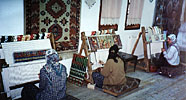 |
 |
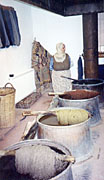 |
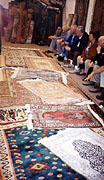 |
| At the carpet factory. (1) Local girls knot the carpets. When the carpet knotters are experienced, they no longer use the patterns these girls are using, but do it from memory. (2) teasing out the silk threads from the cocoons in boiling water The man twirls the twig brush, which catches a few threads, which the woman catches and hangs over hooks to the bobbin spinners. (3) Natural dyes for the wool. Natural dyes are used for wool, but never for silk. (4) A show of the variety of carpet types, from glistening and expensive silk on cotton to cheaper but still luxurious wool on wool. | |||
The carpet factory was interesting in many ways. First, we were shown the process of making the carpets. The girls are local. They are paid what would be a very low wage by N. American standards, but it higher than they could otherwise get in this region (about US$3500/year). Many of them support their families or pay for siblings to go to University out of this money.
 |
| Carpet knots: (Left) Turkish (Right) Persian |
Carpets are made by stringing a base set of threads vertically on the frame. These may be wool or cotton, but never silk. On this base set, the carpet is built of individual knots. In the Turkish carpet, a knot consists of a thread that goes down between two base threads, around, up and over the pair, and then back between the same two base threads. In a Perisan carpet, the knot thread only goes around one of the base threads. Either knot can be tied very quickly with one hand (which seems miraculous) and is nipped off with a blade. When an entire row of knots is finished, the irregularities are cut using a specially made pair of scissors that keep the cut a specified distance above the base threads. It is all very quick, but there are so many knots that a 3ft x 5ft silk carpet of best quality may take 14 months of work, simply knotting. It is no wonder they are expensive!
Next we were shown how the silk is obtained from the silkworm cocoons. Twenty or thirty cocoons are dumped into boiling water, which loosens whatever binds them. It would be impossible for a person to find the loose end, so a man twirls a kind of brush made of knobbly twigs in the water. This catches by chance some of the loose threads. When he has caught several, he passes them over to the woman on the other side of the table, who hangs them individually over hooks and then to the spinners. It takes 25 individual silkworm threads spun together to make what we think of as one nearly invisible silk thread that is wound on a bobbin for later use.
Colouring the thread is also an art. There are natural dyes and acrylic dyes. Natural dyes come from plants, and tend to have reds and yellows, but the indigo dye is an exception. The colour of the wool dyed with indigo depends on how long it has been left in the dye, from a greenish to the deep colour we call "indigo." Natural dyes are used only on wool, because they will not take on silk. If you ever see a new silk carpet and are told it is coloured with natural dyes, you know it is a fake. Similarly, it is a fake if you see a silk carpet with vivid colours that is touted as an antique. Only synthetic dyes are used with silk, because the natural dyes that used to be the only kind available always fade badly, and synthetic dyes were not available in antiquity.
Finally, the manager gave a five-star performance lecture about the sociology and technology of carpets--and to some extent, of Turkey. The picture on the right above shows the climax of the lecture, when one after another different kinds of carpets, from wool-on-wool geometric designs to the most intricate silk-on-cotton were thrown on the floor. Naturally, they hoped that some of us would buy one. And many of us did. We ourselves bought a killim, which is not a carpet. Killims usually go over things, such as tables or camels, whereas carpets go underfoot (even though many are beautiful when used as wall hangings). The killim we bought has a "Noah's Ark" design very similar to that of the Greek carpet we bought in Delphi.
Leaving Cappadocia through rolling hill country that we could now see properly in the sunshine,, we stopped again at Aksary, this time for a very nice cheap lunch. From there we drove west across prairie as flat as anything on the Canadian Prairie, to the south of the Great Salt Lake on the way to Konya.
 |
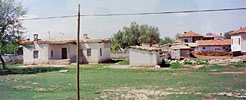 |
| Looking north toward the Great Salt Lake. To the south, there were occasional gullies in the distance, perhaps marking where the lake used to drain when it was much bigger (but not much deeper). | A typical village along this prairie stretch of road. Some of the houses were mud brick, unlike these nicely stuccoed ones. And some were more Western style elegant houses. Always variety in Turkey. |
 |
 |
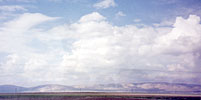 |
| This caravanserai is constructed almost identically to the other one, if with a more complete restoration, and a more ornate entrance (left). (Right) In the summer part, Ahmet discusses a point about the building. | Nearer Konya we could see a range of hills to the north over the plain. The road and the line of hills converged, and met in Konya. |
Konya is quite an interesting town. In some ways, it is a fairly typical town, with areas of nicely coloured apartment blocks, areas of little houses like the ones in the village picture above, and many mosques. But Konya has history rather than antiquities. In the 14th (?) century, it was the home of Rumi, called "Mevlana" the leader or guide, who was a great Sufi mystic and the founder of the religious sect of the whirling dervishes, which is still active today (they were much feared by the English at the seige of Khartoum in the Sudan around 1880). His tomb and the related mosque are fully functioning buildings, rather than restored ruins. We visited a couple of "madresa" or seminaries from the Selc.uk period (13th century) that are now little museums, and we saw Alladin's castle (or what little remains of it) from the 11th century (?).
 |
The Mausoleum and mosque of Mevlana (Rumi)
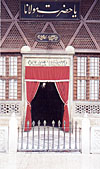 |
 |
| Ceremonial entrance to the mausoleum. |
The mosque is not a very interesting building in itself. But the mausoleum is a strange place, with its own beauty. The mausoleum complex consists of a courtyard like that of a caravanserai, the outer wall of which is filled not with shops, but with a museum (and some shops). The mausoleum iteself also serves in part as a museum devoted to Arabic writing. You can see three styles of script above the ceremonial doorway in the left-hand picture.
As with a mosque, one must remove one's shoes before going into the mausoleum. Inside, the setting is very rich, especially in the area around Rumi's actual sarcophagus (over which the green conical "dome" rises). One side and one end of the building is filled with sarcophagi of both men and women, with Rumi's being the grandest. set in a largely gold surround. The rest of the building is a display area. There are Korans of many sizes, from thumnail to huge, with the most beautiful writing, fully the equal of Mediaeval Christian illuminated manuscripts (even the Book of Kells).
In Konya
 |
| Our hotel in Konya |
From the Mausoleum, we went to our hotel. Inside, it was a standard Western hotel, but it gave itself a Moorish kind of entrance. We had some time to kill before dinner, so I asked about a Web cafe. One of the porters knew where there was one and offered to guide me there as he was just quitting work and going home in that direction. It was in a residential area of apartment buildings with a few small shops, and it was reasonably full.
 |
| Typically coloured apartments. The central stripe is elaborately patterned tilework. |
The picture at the left shows the kind of apartment around where the Web cafe was. They are typical of apartments we saw all over Turkey. Sometimes the coloured stripes would be vertical, sometimes horizontal. Sometimes they would be pastel shades, some times bright colours. Usually if there were several apartments near each other, they would be in pleasinmgly contrasting colours. These particular ones had a central vertical stripe made of elaborately patterned tiles, which was quite unusual.
At the Web cafe, the first person who tried to help me did not speak English, and the instructions were all in Turkish, but a girl came to help who was fluent in English and knew about the computer--in contrast to the people I met later in a Web cafe in Antalya. The Turkish keyboard has several keys that differ from the English, the most difficult character being the @ which is essential for e-mail! The @ sign on the keyboard does not do an e-mail @. There is a three-key combination that does it, a combination I now forget. Half an hour on-line cost 300,000 (about 45c US).
After dinner, the two of us went out for a stroll. The moon was a crescent, and as we walked out of the hotel, it shone just above the tip of the minaret of the mosque on the other side of the street. It was very pretty, and I tried to take a picture, but the camera refused.While I was doing this, we were approached by a group of five boys, 14 or 15 years old. We were a little nervous at first, because we were told that Konya is a religiously conservative town, and Ina was not wearing a headscarf. But it turned out that the boys were equally hesitant about approaching us. What they wanted was to practice their English. Over and again in Turkey we met boys and girls who wanted to talk English with us, but this was the largest group and the only ones we met while we were alone. They were very polite and friendly, though one of them spoke only when spoken to. At 9pm they were on their way from school to catch a train home. We chatted for about half an hour, sometimes in rather halting English, but overall it was a very pleasant experience, which ended when they said they had to run or they would miss their train.
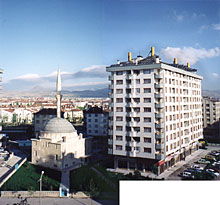 |
| New buildings, in old and new styles, from our hotel window. |
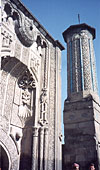 |
| The slender minaret. The larger version shows the wonderful carvings of Arabic writing |
This morning was bright and sunny, for a change, and for once I did not wake up with the 5 o'clock muezzin call that must have sounded from the little mosque outside our window. In the sunshine, we could see over the little mosque and the town to the hills beyond.
Before we left Konya, we visited two small madresa (seminaries, now used as museums). One features scripts, writing, and tilework while the other was for Selc.uk (13th centuy) stone and wood carving. Both were on ,a large traffic circle that surrounded a well treed park. In the park, opposite the first, was another surprise--Aladdin's castle (or rather, some broken walls that used to be part of it). This is actually the Sultan Alâeddin, but it is amusing to imagine that he (or one of the several sultans with that name) was the original of the Arabian Nights Aladdin.
The first madresa, the one opposite Aladdin's castle, was roofed in elaborate ceramic tilework. Originally, the roof was open and there was a pool in the middle of the floor under the opening, but for use as a museum, a cupola with a wood ceiling has been built to cover the hole.
The other madresa was plainer inside, but featured Selc.uk stone and wood carving It has a minaret called "The Slender Minaret" but it was the shortest and stubbiest one we had seen. We though the name was a joke, but it wan't. Originally, it had been four times taller than it now is, but the upper two sections had been destroyed. The middle section was like the existing one but twice the height, and the top one was a replica of the existing section, with a meuzzin calling platform on top.
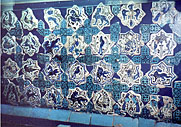 |
 |
 |
||
 |
||||
| (Top left)Aladdin's Castle is protected under a concrete dome.Lower left) some wood printing blocks | (Top middle) some fantasy animals and birds (Lower middle) a 13th century Selc.uk bowl with Arabic script..(middle Right) The tiling of the roof of one of the 13th century madresas. The cupola is modern. (Far right) How the slender minaret might have looked before it lost its upper sections. | |||
After visiting the two madresas, we continued around the same traffic circle, beyond Aladdin's Castle, and left Konya on our way to modernity and to Greaco-Roman civilization.
 |
 |
| We stopped before we got out of Konya for a pit stop. This part of town looks quite different! | A building supply yard on the outsirts of Konya. The ceramic objects in the foreground are chimney pots. A very typical sight. |
Ahmet tolds us as we left Konya that for the rest of the trip we would be seeing Greek and Roman sites. But we started with more modern constructions.
Once we left Konya, it was several hours drive to Antalya, through the Toros mountains. Initially, the terrain was rolling hills, sometimes cultivated, but often not, with rocky sections and forsted sections. In the plains, one could see in the agricultural fields just how much rain there had been recently, by the large lakes that filled many of the fields.
After a while, we began to see the snow-capped Toros mountains that we were going to cross. But then we were stopped at a random police check. One policeman scrutinized Mr orbay's driving licence and talked to him for what seemed like several minutes, while a khaki-uniformed soldier got on the bus an looked us over very carefully. Before we left Istanbul, Ahmet had warned us that this might happen, and told us to keep our passports handy, but the soldier didn't ask to see any papers. He just stood at the bus door and looked at each of us in turn.
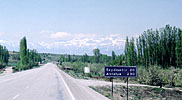 |
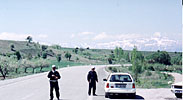 |
 |
| First real sight of the Toros mountains. But what is that in the distance on the road? | A random police check, that's what! A khaki uniformed soldier got on the bus and gave us a careful examination. | At Seydis.ehir, 20 km after the police stop, we had a scheduled stop before starting across the mountains. |
Our early sights of the Toros mountain showed snow-capped peaks, but the road stayed mostly at lower elevations. There were some sections of tight hairpins at the crests of passes, and we did get above the snowline, driving through cleared snowdrifts--which entranced some of our Australian passengers, who had never seen so much snow, or any at all except the little was went through on the way to Cappadocia.
In my diary written the same day, I commented "Several times in this diary I have used words like "magnificent" and "incredible" to describe scenery. They apply multifold to the crossing of the Toros mountains. Sometimes snow peaks, sometimes wide alpine meadows, sometimes high cliffs (above or below the bus). The winding of the hairpins made it very hard to keep a sense of direction. One moment we would be going south, the next north, then west, the north, then south, always upward to one pass and then down to the next valley. In the northern section, the rocks seemd largely to be interspersed tufa and lava flows, but further south they were sedimentary, with many equal layers of limestone perhaps 1 m thick, hundreds or thousands stacked up like pages of a thick grey book."
 |
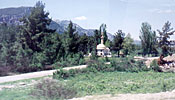 |
 |
|
Scenes crossing the Toros mountains. The little mosque
in the middle picture had two or three houses near it.
|
||
After a while, we emerged from the true mountains onto a high road that overlooked a wide panorama of forested hills. From this high road we first saw the sea on Turkey's south coast (it may just be visible in the left picture below), and then the road dropped steeply down to the coastal plain. There was still a drive of some tens of kilometres before Antalya, along the narrow coastal plain, but most of the time we could not see the sea.
 |
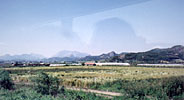 |
 |
| A new subdivision, not far from Antalya. Notice the colours of some of the apartments--and two mosques. |
The coastal plain seems to be very fertile, and there are several "greenhouse farms" to enhance the productivity. Indeed, coming into Antalya, it even looked as if the tall apartment forests grew by dropping seed and sprouting new buildings instead of tree saplings!